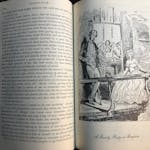We simply cannot get enough of Laura Ingalls Wilder. She wrote nine "Little House" books, and we read them all and clamored for more. The journal she kept of her move from the Dakotas to Missouri was unearthed in 1962 and was published as "On the Way Home," and that was not enough.
Michael Landon created a TV show out of the books. It lasted nine seasons, and still we were not sated.
The Library of America published a scholarly, annotated boxed set of the "Little House" books. The South Dakota Historical Society published Wilder's memoir, "Pioneer Girl," and it sold out so quickly it threw everyone into a tizzy.
Still. Not. Enough.
This year there are several new Wilder books to choose from, including a biography due to appear in November ("Prairie Fires"). Here are three:
"Pioneer Girl Perspectives," edited by Nancy Tystad Koupal, came out in May from South Dakota Historical Society Press. This collection of essays from Wilder scholars explores the world behind the books, including Wilder's collaboration with her daughter and the dueling illustrations by Helen Sewell and Garth Williams.
"The World of Laura Ingalls Wilder" by Marta McDowell (Timber Press, Sept. 20) looks at the natural world — the plants, landscape and animals — of the different places the Wilder family lived. (McDowell will be at Magers & Quinn, 3038 Hennepin Av. S., Mpls., at 7 p.m. Sept. 21.)
Sarah Miller turned to fiction. Her novel "Caroline" (William Morrow, Sept. 19) is a retelling of "Little House on the Prairie" through the eyes of Ma Ingalls.
And now, I'm going to turn this column over to my colleague, Lee Svitak Dean, who read "Caroline" (and who reads everything about Laura). Dean writes:
What did Ma Ingalls think as Pa hitched up the wagon to drive the family from Wisconsin to Kansas in 1870?
We'll never know, of course, but Sarah Miller takes that perspective as inspiration for "Caroline." Miller honors the original tale — the book was written with the approval of the Little House Heritage Trust — and tells Caroline's story in a voice strikingly similar to Wilder's, though with a maternal perspective that's aware of the danger and hardship of pioneer life.
Like Wilder, Miller provides extensive details of life on the prairie (covering a wagon, building a house, making meals, giving birth). But she also includes the unmentionables that missed the children's series (any need for the latrine was referred to as "the necessary" and, of course, Ma and Pa have some romance under the quilts).
Switching the focus of a book serves as an interesting writing exercise. But of all the volumes in the series, this one seems the most curious to replicate, given its controversial depiction of American Indians. "Caroline" focuses on a move to what is called Indian Territory. Caroline and other homesteaders are terrified of the Osage tribe, on whose homeland they settle. Miller's descriptions of the encounters between the two groups is uncomfortable for today's reader, much as is a rereading of "Little House on the Prairie."
A reference to the "Minnesota massacre," known as the U.S.-Dakota War of 1862, finds its way into this story, as homesteaders worry about potential "trouble" in Kansas. Even 155 years later, the subject still unsettles many in Minnesota, native and non-native alike.
One year after their move, the Ingallses pack up their wagon yet again. "Little House" blames it on politicians and the Indians, but Miller clarifies the historical error, as she does on a few other occasions in "Caroline." This move was due to financial reasons back in Wisconsin. The Ingallses wouldn't be permanently settled for years.
Laurie Hertzel is the Star Tribune senior editor for books. On Twitter: @StribBooks






